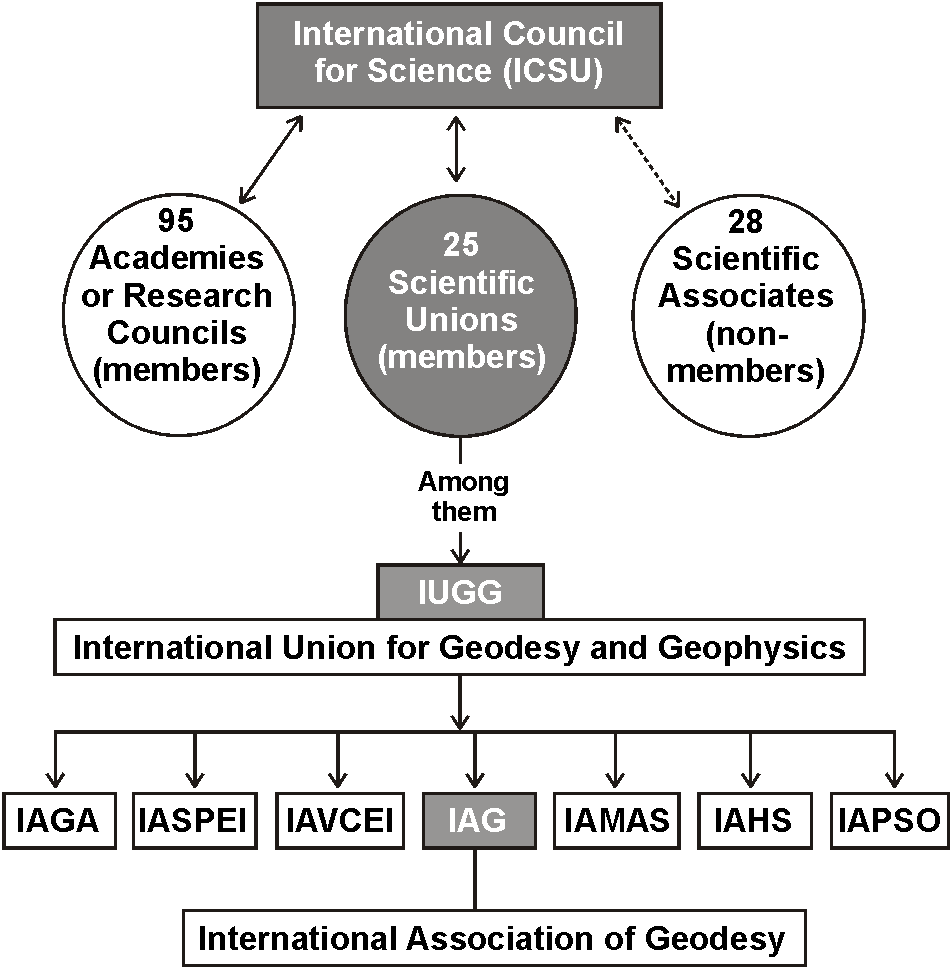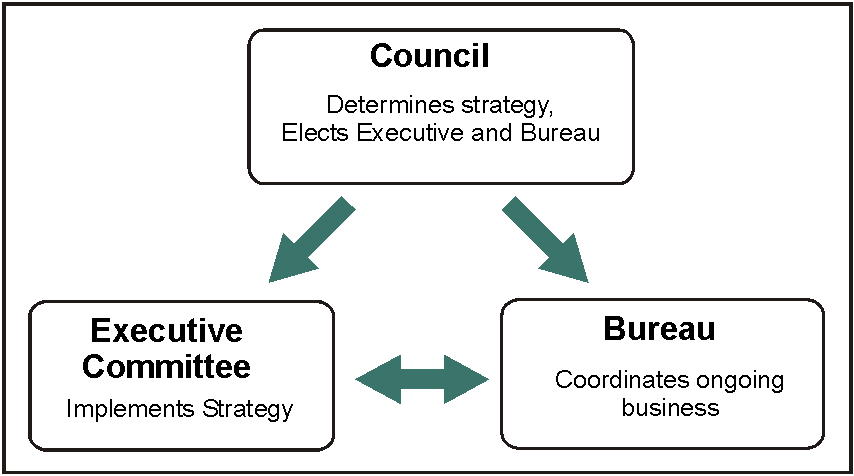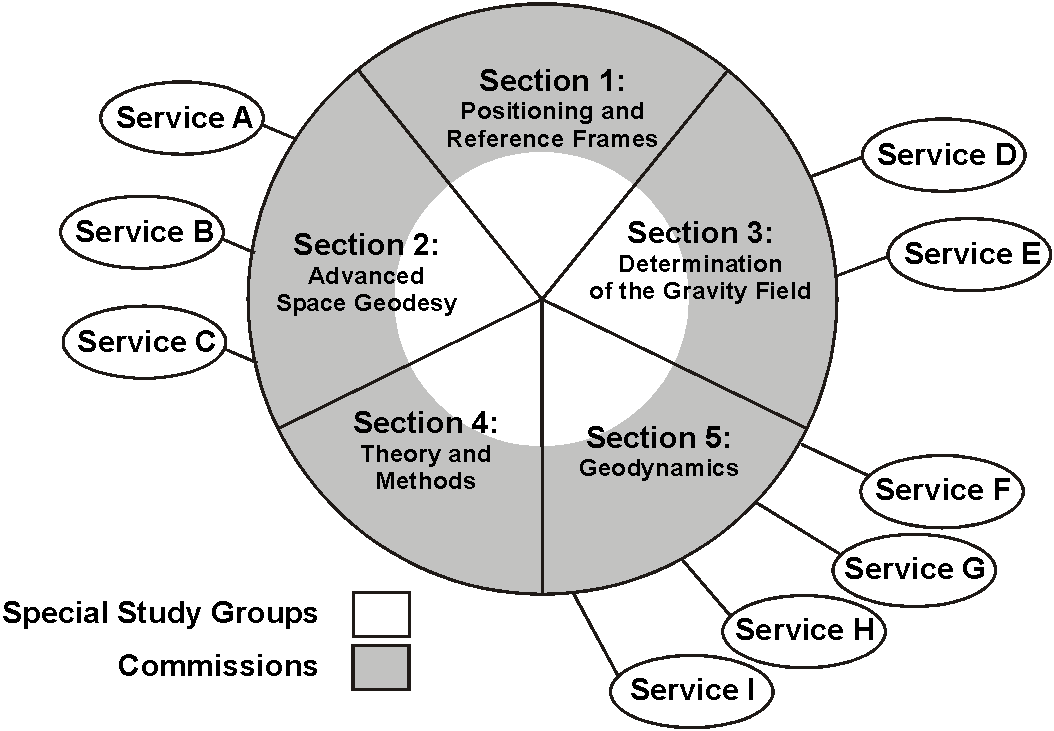
What is the IAG?
K.P. Schwarz - Honorary President
Department of Geomatics Engineering, The University of Calgary, Canada.
1. The IAG in the Framework of International Science
The International Association of Geodesy (IAG) is a scientific organization in the field of geodesy. It promotes scientific cooperation and research in geodesy on a global scale and contributes to it through its various research bodies. It is an active member of the International Association of Geodesy and Geophysics (IUGG) which itself is a member of the International Council for Science (ICSU).
The IAG has a long and distinguished history that goes back to 1862, the year, in which the "Mitteleuropäische Gradmessung" was established. This organization was formed to promote scientific work in geodesy in Central Europe, following a proposal made a year earlier by J.J. Baeyer (1861). In 1867, the name of the organization was changed to "Europäische Gradmessung", because by then countries from all of Europe had joined the organization. In 1886, the name was changed to "Internationale Erdmessung", emphasizing the need for international cooperation to solve the scientific tasks of geodesy. The French and English translations of this name resulted in the current name "International Association of Geodesy (IAG)". Thus, the IAG as an international scientific organization goes back to 1886 and is one of the oldest international organizations of this kind. For details on the early history of the Association, see Perrier (1939), Tardi (1963), Levallois (1988), and Torge (1993).
The initial charter of the Association required that the funding of the organization be renewed every 10 years by agreement of the participating countries. In 1917, this did not happen because of the First World War. After the hostilities ended, the former IAG was restructured and became part of the "International Union of Geodesy and Geophysics (IUGG)". As the name IUGG indicates, geodesy was not seen any longer in isolation but as a partner of geophysics. This opened a much wider arena of interdisciplinary research and proved to be a major advantage when geodesy entered the space age. It also resulted in severe financial limitations compared to the original arrangement, see Tardi (1963) for details, a drawback which has severely limited the capability of the IAG to fund research initiatives.
The IUGG was part of a new structure, called the "International Research Council (IRC)", that provided a common roof for research across the whole spectrum of science. It was formed in 1919 and replaced in 1931 by the "International Council of Scientific Unions (ICSU)", due to controversies about the discrimination against scientists from specific countries. ICSU affirmed the rights and freedom of scientists throughout the world to engage in international scientific activity and has consistently taken a strong stand for non-discrimination - a stand that is supported by all its members. In 1998, the name of the Council was changed to "International Council for Science", while maintaining the acronym ICSU for the organization. ICSU promotes "international scientific activity in the different branches of science and their applications for the benefit of humanity", see ICSU (1999). This objective is implemented in a number of different ways, as for instance by coordinating major international and interdisciplinary research programs, by creating interdisciplinary bodies, which undertake activities of interest to several member bodies, and by addressing issues of common concern to all scientists. ICSU has two categories of membership: Scientific unions are international and organized along scientific disciplines, while academies or research councils are national and multi-disciplinary in nature. Currently, there are 25 members of the first type and 95 of the second. In addition, there are 28 scientific associates.
In Figure 1, a simplified diagram is used to show the IAG and the IUGG in their relation to ICSU. The IUGG is one of the 25 unions of ICSU and consists of seven associations. Besides geodesy, the following disciplines of geophysics are represented by associations: Seismology and Physics of the Earth’s Interior (IASPEI), Volcanology and Chemistry of the Earth’s Interior (IAVCEI), Geomagnetism and Aeronomy (IAGA), Meteorology and Atmospheric Sciences (IAMAS), Hydrological Sciences (IAHS), and Physical Sciences of the Oceans (IAPSO). Joint research between the IAG and the other associations has considerably increased since space methods have become a major tool. Currently, it is especially strong with IASPEI, IAMAS, and IAPSO. Some of this interaction is channeled into specific organizational structures, but much of it comes about by scientists cooperating on topics of mutual interest. This cooperation has been strongly encouraged by the IUGG which promotes inter-association symposia at its general meetings where results of interdisciplinary research can be presented.

Fig. 1 IAG in the Framework of ICSU
Over the more than hundred years of its existence, the role of the IAG within the framework of international science has considerably changed. While it started out as a pioneer in international scientific cooperation, its role changed in 1919 when it became a partner of geophysics and a part of a much larger scientific organization. This change was not easy and for some time afterwards a major goal of the Association was to emphasize the uniqueness and strong scientific tradition of the IAG. Today, the distinction between geodesy and geophysics is less of an issue. Instead, the interaction with other disciplines and the potential for joint research within the framework of the IUGG and other scientific unions, have become much more important. It appears that by being receptive to the challenges of interdisciplinary research, geodesy has gained in stature and has started to play a more significant role for science as a whole.
2 IAG Research Objectives and Organizational Structure
Research Objectives
The main objectives of the IAG as stated in the Statutes (I,2) are:
| to promote the study of all scientific problems of geodesy and to encourage geodetic research | |
| to promote and coordinate international cooperation in this field, and promote geodetic activities in developing countries; | |
| to provide, on an international basis, for discussion and publication of the results of the studies, research and work indicated above. |
In terms of research, the definition is rather broad (all scientific problems) and its implementation rather vague (promote, encourage). It reflects the current reality of the IAG which, as a scientific organization with minimal financial support, depends on the quality of its scientific work and on the benefits of international scientific cooperation. In such a structure, the priorities are essentially decided by peer consensus and are minimally influenced by funding decisions of the organization. In this way, it provides a rather open environment for future-oriented research. On the other hand, because of the large diversity of research topics that are treated simultaneously, the research profile of the organization remains rather unfocussed.
The Administrative Structure
The current IAG structure can be subdivided into an administrative and a scientific part. The administrative structure is shown in Figure 2 and consists of the Council, the Executive Committee, and the Bureau.

Fig. 2 The Administrative Structure of the IAG
The Council is made up of national delegates accredited by member countries. It meets once every four years and determines the overall strategy of the Association, as defined in the Statutes (II,7):"Responsibility for the direction of the Association affairs shall be vested in the Council of the Association." One of its major tasks is the election of officers for the Executive Committee and the Bureau. Another is the approval of major changes in the scientific structure of the Association.
The Executive Committee (EC) consists of officers elected by Council and meets, on average, once a year. It implements the strategy adopted by Council by providing coordination between the numerous scientific bodies of the Association and by making major policy decisions, as defined in the Statutes (II,10): "The duties of the Executive Committee shall be to further the scientific objectives of the Sections and other scientific bodies of the Association through effective coordination and through the formulation of general policies to guide the scientific work of the Association."
The Bureau consists of three elected officers – the President, the First Vice-President, and the Secretary General. It meets in conjunction with each EC meeting and otherwise as required. The Bureau coordinates the ongoing business, as defined by Council and EC decisions, see Statutes (II,9):"The duties of the Bureau shall be to administer the affairs of the Association in accordance with these Statutes and By-Laws and with the decisions of the Council and the Executive Committee."
The Scientific Structure
The scientific work of the IAG takes place in Sections, Services, Commissions, and Special Study Groups. As indicated in Figure 3, Sections provide a subdivision of geodesy into five major slices which currently are: Positioning and Reference Frames, Advanced Space Techniques, Determination of the Gravity Field, Theory and Methods, and Geodynamics. In a way, sections provide a framework for the objective to study "all scientific problems of geodesy", but they are not the source of active research. Research takes place in the Commissions and Special Study Groups (SSG) which are the organizational units for long-term and short-term research, respectively. Each Section has therefore a number of Commissions (or Special Commissions) and SSGs which define the research done in a specific section. The Section Steering Committee coordinates interaction between the research units, organizes collaboration across sections, and represents the section in the Executive Committee
.

Fig. 3 The Scientific Structure of the IAG
Services come in a variety of forms. They can be subdivided into three major groups: documentary services, such as the IAG Bibliographic Service; data-based services, such as the IGS and the BGI; and topical services, such as the IERS and the IGeS. While the first group serves the IAG exclusively, this is generally not the case for the other services. Although most of them grew out of the IAG, many of them have a much wider constituency and are truly interdisciplinary in nature. Traditionally, the major role of the data-based services has been data collection and dissemination. Today, most of them also offer products derived from such data and therefore overlap with the topical services in some areas. Services have always played an important role in IAG work. They have, however, increased in importance over the last decade and often represent the IAG profile to the larger scientific community. In view of that, it is all the more surprising that they do not have a clearly defined role in the current Statutes and By-laws. Although services are in general assigned to sections, they do not fit this structure well.
Commissions and Special Commissions are defined as IAG bodies for long-term research. Commissions are formed where global or regional cooperation is required to achieve long-term goals. Special Commissions are more topical in nature and are formed where the solution of a specific scientific problem requires the cooperation of scientists from different countries. The boundary between the two varieties is somewhat fluid.
Special Study Groups are research units to solve specific scientific problems of limited scope. Their lifetime is usually restricted to one period of four years. They are the units in which highly technical and specialized research is done and where young scientists often make their entrance into the Association.
3 Brief Analysis of the Current IAG Structure
In recent years, the question whether the current structure adequately represents IAG research priorities and provides a visible focus for IAG work has been frequently discussed in the IAG Executive. It has been raised in a wider forum during the last general Assembly in Birmingham. To give some background to that discussion, a brief review of some of the major arguments will be given in the following. It will follow the topical sequence of the preceding chapter.
In general, the administrative structure has worked well for the IAG. The use of e-mail as a major means of communication has strengthened the link between Bureau and Executive Committee and has provided a means to make decisions between EC meetings in an efficient and democratic way. What may be required in the future is a more active involvement of Council members in the ongoing discussions of the Executive Committee, in order to better prepare the quadrennial Council meetings and provide continuity for the decision making process. The latter would require that a majority of national delegates are on the Council for more than one period. This seems to be the case for the delegates at the two last Council meetings.
The scientific structure may be in need of a major overhaul, although opinions differ as to the specific changes necessary. The Section structure was introduced 50 years ago with the intent to create more manageable units which, as a whole, would cover all important aspects of the discipline. The advantage of this structure is that research areas that are either small or not fashionable have a chance to find their place in such a structure. Its drawback is that it concentrates attention on section research and does not encourage a common IAG research focus. Thus, individual scientists are often more attached to a specific section than to the Association as a whole. Geodesy becomes subdivided into compartments which, in the worst case, degenerate into fiefdoms. Fundamental change in a discipline is difficult to accommodate in an established section structure, as the emergence of space geodesy has shown. In such cases, the existing structure can become a dead weight for progress.
With the increasing need for data and research products, Services have experienced a renaissance during the last decade. One reason is the increasing willingness of countries to share their data because the integrated product they are receiving in return is of considerable value to them. Thus, financing is largely in-kind and can be done with a relatively small overhead. In order to attract a larger customer base, they usually had to move away from their IAG origins. Many of them have developed from IAG Services to FAGS Services and now serve the much larger geophysical and astronomical community. Their link to specific IAG sections is often tenuous and their influence on IAG decisions indirect at best. Their integration into a future IAG structure is important because they often present the IAG profile to the larger scientific community. To make changes in such a way that their range of activities is enhanced rather than restricted, is the challenge to be met.
There is no question that Commissions have very effectively contributed to many areas of geodetic research. There is no question either that many of them have existed well beyond their useful lifetime. The fact that they are defined in terms of long-term research goals makes them often immune to change and very slow to adapt to change in observational or numerical techniques. In terms of structure, there have been a number of cases where a specific Section and a specific Commission were almost exchangeable. Each one could have well existed without the other and nothing essential would have been lost. Similarly, the overlap between commissions and topical services can be large. The fact that most other associations of the IUGG have a structure consisting of long-term and short-term research units only, indicates that the administrative overhead in the IAG is too heavy
Special Study Groups are research units to solve specific scientific problems of limited scope. There is little doubt that any scientific organization needs working groups of this type. Their problem, however, is effectiveness. SSGs that achieve enough synergy to come up with results that can be considered as a group effort are still rare. Many of them simply exist as clearing houses for pre-publications or as information collectors. The current attempts to replace what is essentially a top-down approach by a bottom-up approach may help to alleviate this problem. Tying such working groups to major scientific projects in the Commissions or Services may be another way.
Finally, important changes in the scientific and organizational structure of the IAG are essentially tied to the General Assemblies. This means that the response time is typically four years and may be as much as eight years. The organizational dynamics created by this makes it very difficult to respond to new challenges in a flexible manner and to implement decisions as quickly as desirable. Although the IAG Executive has found ways to interpret the Statutes and By-laws in a creative manner in order to respond more quickly, more flexibility in the IAG structure would greatly benefit our organization.
At the General Assembly in Birmingham, both the IAG Executive and the IAG Council agreed to a plan and a timeline to review the IAG structure. A Committee was appointed to set this process in motion. The Committee will present its proposal to the Scientific Assembly that will meet in Budapest in the summer of 2001.
References